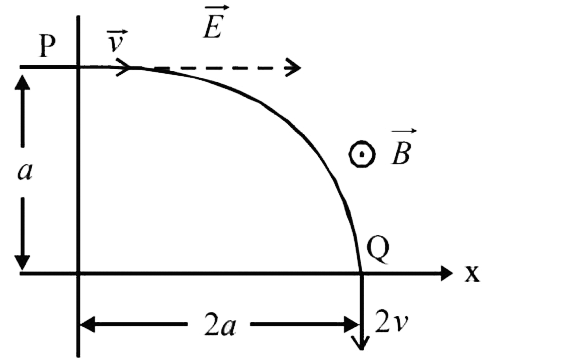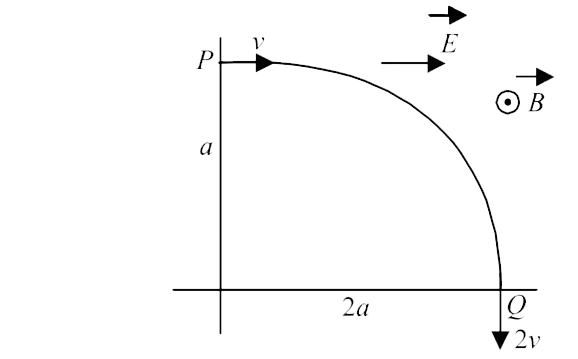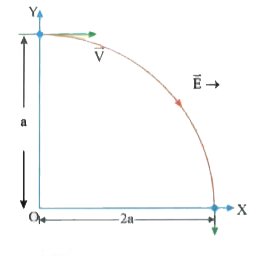A particle of charge +q and mass m moving under the influence of a uniform electric field Eˆi and uniform magnetic field Bˆk follows a trajectory from P→Q as shown in fig. The velocities at PandQ are vˆi and −2vˆj . which of the following statement(s) is/are correct ?

E=34[mv2qa]
Rate of work done by the electric field at P is 34[mv3a]
Rate of work done by the electric field at p is zero
Rate of work done by the electric field at Q is zero
The correct Answer is:A, B, D
Considering the activity from P→Q ( Horizontal)
u1=v,v1=2v,s1=2a,A=A
rArr 4v2−v2=2A(2a)
rArr A=3v24a
Force acting in the horizontal direction is
F=qE=mA
rArr E=mAq=34[mv2qa]
Rate of doing work A P
power =F×v=mA×v=34[(mv3a]
Rate of doing work by the magnetic field is throughout zero. The rate of doing work by eletric field is zero at Q . Because at Q , the angle between force due to electric field and displacement is zero .

Topper's Solved these Questions
- MOVING CHARGES AND MAGNETISMBOOK - SUNIL BATRA (41 YEARS IITJEE PHYSICS)CHAPTER - MOVING CHARGES AND MAGNETISMEXERCISE - MCQs(d )
1 Videos
- MODERN PHYSICSBOOK - SUNIL BATRA (41 YEARS IITJEE PHYSICS)CHAPTER - MODERN PHYSICSEXERCISE - MCQ (One Correct Answer
1 Videos
- RAY AND WAVE OPTICSBOOK - SUNIL BATRA (41 YEARS IITJEE PHYSICS)CHAPTER - RAY AND WAVE OPTICSEXERCISE - JEE Main And Advanced
209 Videos
Similar Questions
A particle of charge q and mass m starts moving from the origin under the action of an electric field →E=E0ˆi and →B=B0ˆi with velocity →v=v0ˆj. The speed of the particle will become 2v0 after a time
View SolutionAn alpha particle moving with the velocity →v=uˆi+ˆj ,in a uniform magnetic field →B=Bˆk . Magnetic force on alpha particle is
View Solution
Knowledge Check
A particle of charge +q and mass m moving under the influnce of a uniform electric field Eˆiand a uniform magnetic field Bˆk follows trajectory from P to Q as shown in figure. The velocities at P and Q vˆi and −2vˆj respectively. Which of the following statement(s) is/are correct
 AE=34mv2qaBRate of work done by electric field at Pis 34mv3aCRate of work done by electric field at P is zeroDRate of work done by both the fields at Q is zero
AE=34mv2qaBRate of work done by electric field at Pis 34mv3aCRate of work done by electric field at P is zeroDRate of work done by both the fields at Q is zeroA particle of charge q and mass m starts moving from the origin under the action of an electric field →E=E0ˆiand→B=B0ˆi with a velocity →v=v0ˆj. The speed of the particle will become 2v0 after a time.
At=2mv0qEBt=2Bqmv0Ct=√3Bqmv0Dt=√2mv0qEA particle ( mass = m and charge = q ) is moving in a region in which there exists a uniform electric field E→i and a uniform magnetic field Bˆk. At t = 0 , the particle is at ( 0,a ) and is moving with vˆi. After some time, the particle is located at ( 2a, 0 ) and has a velocity −2vˆj , then which of the following is true ?
AE=32(mv2qa)Bat the initial moment, the rate of work done by electric field is 34(mv3a)CE=38(mv2qa)Dat the initial moment, the rate of work done by electric field is 316(mv3a)
A particle of charge q and mass m released from origin with velocity →v=v0ˆi into a region of uniform electric and magnetic fields parallel to y-axis. i.e., →E=E0ˆjand→B=B0ˆj. Find out the position of the particle as a functions of time
Strategy : Here →E∣∣→B
The electric field accelerates the particle in y-direction i.e., component of velocity goes on increasing with acceleration
ay=Fym=Fem=qE0m
The magnetic field rotates the particle in a circle in x-z plane (perpendicular to magnetic field) The resultant path of the particle is a helix with increasing pitch.
Velocity of the particle at time t would be
→v(t)=vxˆi+vyˆj+vzˆk
View SolutionIf the vectors 2ˆi−qˆj+3ˆkand4ˆi−5ˆj+6ˆk are collinear then find the value of q.
View SolutionAn electron of charge −e, mass m, enters a uniform magnetic field →B=Bˆi with an initial velocity →v=vxˆi+vyˆj. What is the velocity of the electron after a time interval of t seconds?
View SolutionFigure 2 (EP). 13 shows the orientatione of two vectors →u and →v in the (XY) plane.
If →u=aˆI+bˆj and →v=pˆ+qˆj which of the following is correct ?
 .
.
View SolutionA particle having change q and m is projected with velocity →v=2ˆi−3ˆj in uniform electric field →E=E0.ˆj change in momentum |Δ→p| during any time interval t is given by :
View Solution
